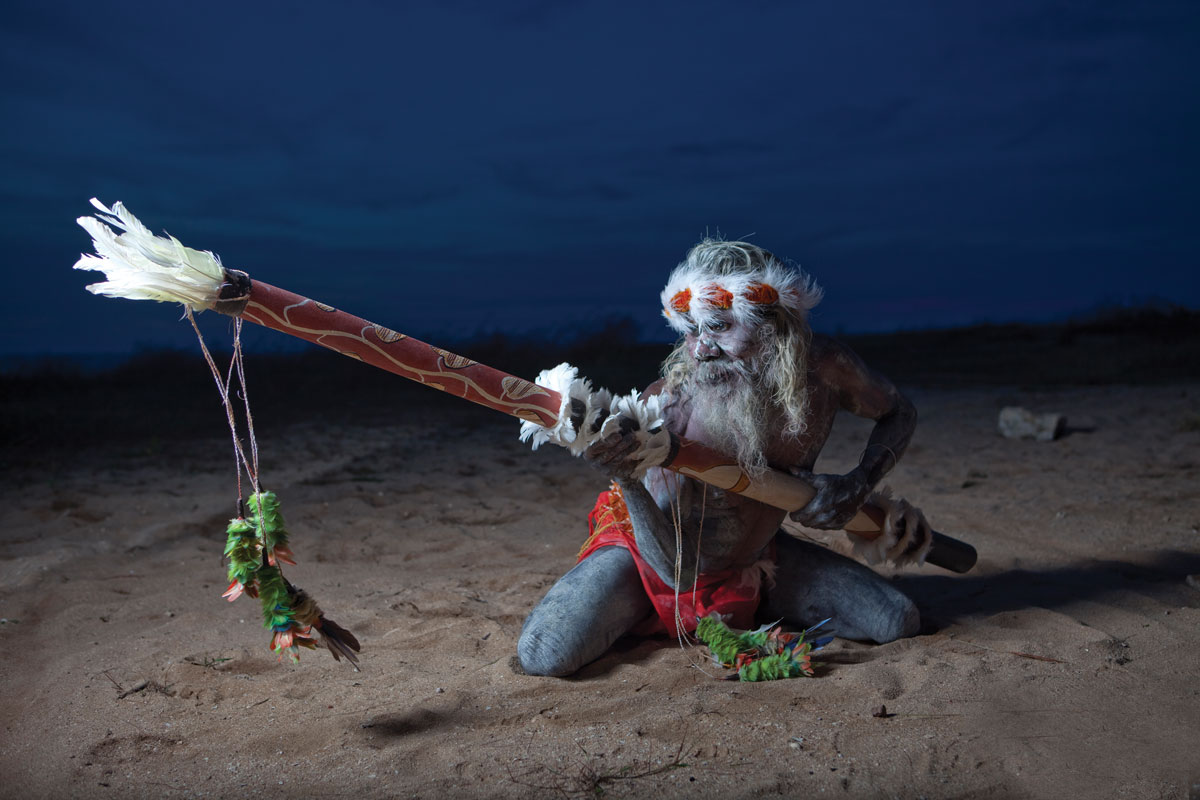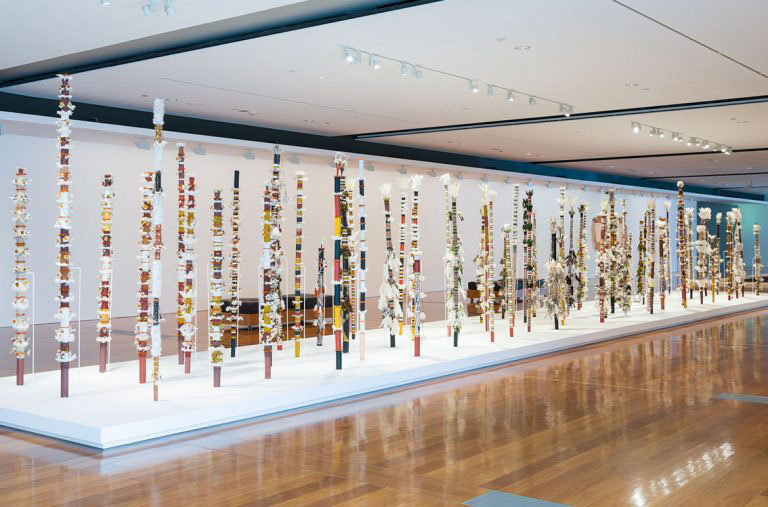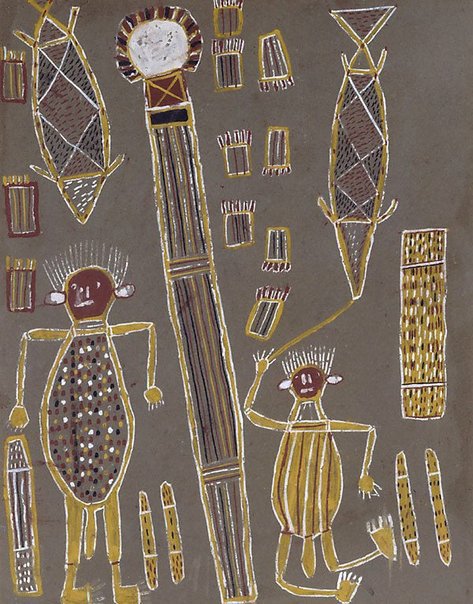RIP Malu Gurruwiwi – Custodian of the Banumbirr

Malu Yalkarriwuy Gurruwiwi, Dancer and Custodian of the Banumbirr
Posted by Jeremy Eccles | 02.06.20
Gallery: Vivien Anderson Gallery
It is with great sadness that the Vivien Anderson Gallery has announced the passing of Malu Gurruwiwi, custodian of the Banumbirr - Morning Star ceremony. He lived from1942 to 2020 as a proud member of the Galpu and Djapu Clans.
Malu was a passionate advocate for the maintenance of Yolngu culture, his determination to share the Banumbirr with the outside world saw him travel the world as a dancer, as an eloquent orator and as an artist.
Gali Yalkarriwuy Gurruwiwi, was born in 1942 on Millingimbi island, eastern Arnhem land. Not long after he was born, his family was moved to the Methodist Mission on Galiwing’ku (Elcho Island) to reduce the risk of casualties from Japanese bombing attacks targeting the Airforce based on Millingimbi. Malu’s father, Gapuka was one of the last surviving custodians of the Banumbirr ceremony; the Banumbirr revolves around the very bright morning star, Venus, which sets in the west just before dawn, heralding the daylight. At sunset it then leaves its bathi (basket) and travels across the clans' lands on a feathered string, and guides the souls of those recently departed top the island of Burralku. Burralku is akin to heaven, a ‘promised spiritual country, the next stage of life after death. Life repeats then moves on to the next cycle’. In the morning, it returns to its bathi.
“It was very important to my father that I know the story of Banumbirr. He was the last from all the clans who knew the stories so he was custodian of the Banumbirr pole. He taught me that Banumbirr was the brightest star in the sky. It rose in the east, crossed each clan’s country and set in the west, just before the dawn. He taught me that it symbolised the cycle of life and the metamorphosis that occurs within it”.
When Malu was a young boy in the 1950s, Gapuka and the Galpu clan leaders could no longer tolerate the erosion of their culture due to Missionary interference and decided to recreate ceremony so that it could be performed and shared with the outside world. This meant the formal eradication of hair, blood, and bone from the Banumbirr ceremony, which pivoted around ornate feathered head dresses, armbands, and a sacred woven dilly bag, representing the resting place of the Morning Star at night. The Morning Star pole re-emerged as a sapling stripped of its bark, painted in clan designs in earth pigments, fixed with long bush string talons on which clusters of iridescent feathers from lorikeets, brolgas, black cockatoos and budgerigars hang.
Malu was aware of the two colliding cultures in his life, he managed to reconcile his cultural obligations with his Christian faith and became a leader in the church on Galiwing’ku. Malu travelled extensively throughout the world; to Israel to bear witness to his Christian beliefs, and to Canada where he shared the Banumbirr alongside Canadian First Nation's own Morning Star ceremony.
“I was confused. At the mission I went to church and learned how Jesus was our saviour. I listened to the sermon and heard them say:
'So we are even more confident of the message proclaimed by the prophets. You will do well to pay attention to it because it is like a lamp shining in a dark place until the day dawns and the light of the Morning Star shines in your heart'.I knew from that moment on my Yolngu faith must be true. The Banumbirr I knew was also spoken of in the bible. It was a great realisation in my life. I went forwards with great confidence knowing my faith in my culture had been restored”.
During the last twenty years of his career Malu staged almost annual exhibitions with Melbourne's Vivien Anderson Gallery including solo exhibitions and collaborations alongside his family, also with from Tiwi Island, and Djirrirra Wunungmurra from Yirrkala in eastern Arnhemland. Malu was included in numerous curated institutional exhibitions, a highlight being the dominance of his extraordinary installation of Banumbirr in Lucent at the Queensland Art Gallery in 2016.
Malu was also rewarded with several honours: he was the recipient of the 2008 Kate Challis RAKA Award, was a finalist in the inaugural $50,000 Western Australian Indigenous Art Awards, and was proclaimed the inaugural Monash University Indigenous Elder. In 2011 Malu won the Wandjuk Marika 3D Memorial Award at the 28th National Aboriginal and Torres Strait Islander Art Awards for his presentation of two supersized Banumbirr representing husband and wife.
In 2010 it was easily within Malu’s stride that he would travel from Galiwing’ku to Santa Fe in New Mexico to exhibit in Australian Contemporary Indigenous Art Now, presented in association with Vivien Anderson Gallery and Chiaroscuro Gallery, before flying on to London for a solo exhibition at Rebecca Hossack Gallery.
In 2015, Malu received national news coverage when he travelled 3000 kilometres to perform the traditional 'Lunggurrma' dance with his granddaughter Sasha at her year 10 graduation at Worowa College in Healsville, Victoria. Later in his career Malu would expand his repertoire to create families of Banumbirr; he would say they travelled to him from across the sea, into his arms and away again to be shared with the world.
Banumbirr by Malu can be found in the collections of prestigious institutions and private collections across the world including the National Gallery of Australia, Canberra ACT, National Gallery of Victoria, Art Gallery of New South Wales, Museum of Contemporary Art, Museum and Art Gallery of the Northern Territory, Monash University Museum of Art, Australian National Maritime Museum, Hood Museum of Art, Dartmouth College, USA, and the Arnaud Serval Collection, Paris.
Malu was a charismatic man, with the comportment of a dancer and a penchant for rock star attire. He rarely went unnoticed wherever he went. He enjoyed the wonder his forests of Banumbirr inspired in audiences around the world, it warmed him to know he was actively bringing his culture to the world.
Perhaps these are the most fitting final words: “I make Banumbirr poles without the bone or hair for balandas so that they may learn about us and be respectful of our culture. I openly and confidently share my story straight from the heart”.
Malu is survived by his wife Jane Garatju, sons Paul Buwang Buwang and Trevor Bararra Gurruwiwi, grandchildren, great-grandchildren and nieces and nephews. His grandson Matthew Gurruwiwi took home the Emerging Artist prize at the NATSIAAs in 2018 for his set of five Morning Star poles. He told Aboriginal Art Directory then: “I was raised to be an artist. Making Banumbirr has been passed on to me and it is important I keep doing it and keep my culture strong”.
Malu has been part of the fabric of Vivien Anderson Gallery since 2007. Jane Garratju and Malu adopted Vivien in 2010.
Images of the deceased are used with the permission of his family
URL: https://www.vivienandersongallery.com/artists/gali-yalkarriwuy-gurruwiwi
Share this:
»  del.icio.us
»
del.icio.us
»  Digg it
»
Digg it
»  reddit
»
reddit
»  Google
»
Google
»  StumbleUpon
»
StumbleUpon
»  Technorati
»
Technorati
»  Facebook
Facebook
Contact Details
Gallery: Vivien Anderson Gallery
Contact: Vivien Anderson Gallery
Email: info@vivienandersongallery.com
Telephone: +61 3 9509 0255
Address: 470 Dandenong Road Caulfield North 3162 VIC

Gali Gurruwiwi's assembled families of Banumbirr in the 'Lucent' exhibition at the Queensland Art Gallery

Binyinyuwuy Djarrankuykuy painting, 'Banumbirr' collected by Mountford in 1948, on show at the newly reopened Art Gallery of NSW exhibition, the excellent 'Under the Stars'
Where is the exhibition?
Further Research
Gallery: Vivien Anderson Gallery
Artists: Djirrirra Wunungmurra | Gali Yalkarriwuy Gurruwiwi | Gapuka Gurruwiwi | Jean Baptiste Apuatimi | Matthew Gurruwiwi
News Tags: AGNSW | Banumbirr | Burralku | Galiwing’ku | Jeremy Eccles | Morning Star | NATSIAAs | Vivien Anderson
News Categories: Australia | Blog | Event | Exhibition | Feature | Industry | News | OBIT
Exhibition Archive
- 02.06.20 | RIP Malu Gurruwiwi – Custodian of the Banumbirr
- 11.05.20 | BIDYADANGA CLOSE-UP
- 07.05.20 | Boomerang Back to the Start
- 29.04.20 | Cooked???
- 24.04.20 | Mrs Ngallametta
- 23.04.20 | NATSIAA Pre-Selections Revealed
- 20.04.20 | CIAF 2020
- 10.04.20 | Marginally Good News
- 06.04.20 | ON & OFF IN ABORIGINAL ART
- 26.03.20 | Out on Country!
- 19.03.20 | BIENNALE OF SYDNEY 2020
- 13.03.20 | LAURIE NILSEN
- 03.03.20 | EMILY v CLIFFORD
- 02.03.20 | The Ephemeral and the Ineradicable
- 25.02.20 | WADJUK IN THE BLACK
Advertising

